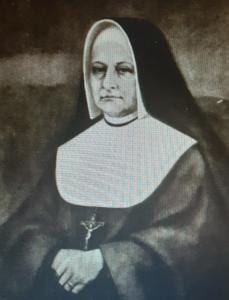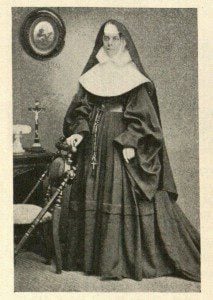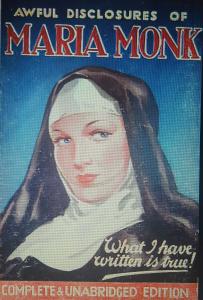This order dates its beginning nearly three centuries back and was founded by a zealous missionary priest, the Blessed John Eudes, also founder of the Congregation of Jesus and Mary, or Eudist Fathers. Its object and work are identical with all the houses of the Good Shepherd. Its chief aim is the reclamation of girls and women from the downward course of recklessness and sin. In 1855 began this admirable work in Buffalo, when Right Rev. John Timon, D.D. , first Bishop of Buffalo, introduced this community into his diocese, going himself to France to bring the first four Sisters from their Convent in Rennes, to begin the work of foundation. The seed was thus brought from a foreign country and planted in American soil.
Mother M. of St. Jerome Tourneau was the Superior and under her prudent and zealous direction, the first four houses were established. In time, institutions were founded in many cities of the United States, Canada, and Mexico: Ottawa; Toronto; Vancouver, B.Cc., and Edmonton, Canada; two houses in Pittsburgh, Pa.; one in Green Bay, Wis.; San Antonio, Texas; Dallas, Texas; Wheeling, W. Va.; Hot Springs, Ark.; Superior, Wis.; and two in Mexico.
The convent in Buffalo, stately and imposing as it looks today, was cradled in extreme poverty, and struggled for many years through trials and difficulties of every kind. But the Sisters rose to every occasion, and prospered as only those do who are resolved to do and dare for God alone. The present gray pile of buildings, which cover nearly a block, attest the spirit of progress that actuated that heroic band and their successors. During all those years, thousands have been housed and lovingly and carefully treated in this asylum.
The home is strictly non-sectarian: Jew and Gentile find here a refuge, and on leaving their kind mothers, as the inmates commonly call the religious, carry away with them much useful knowledge, as well as tender recollections of their stay. No rule exists as to the length of time a girl must or ought to stay in the asylum or reformatory. Many who have quitted the scenes of their former lives or who have been compelled by circumstances beyond their control to reside here for a stated time decide to remain longer after the period of detention has passed. They often remain for the period of their natural existence serving God by a life of penance and prayer.
The different classes are presided over by one or more of the religious. The younger girls attend school are taught needlework and many other useful branches, as well as vocal and instrumental music. The grounds are extensive and beautifully laid out, with a view to economy as well as ornamentation, while the concrete walks and promenades contribute much towards supplying space for free exercise for the young girls, as also a fine spacious pavement for outdoor games, drills, calisthenic exercises, etc.
The chapel was built in 1888, and is cruciform in shape, while the sanctuary is so placed that it serves as an intermediary between the nuns’ choir and the transepts ,or side chapels for the inmates. The community is self supporting. An occasional bequest comes to lighten the efforts of those hard working sisters who in the main depend after God on their own industry, mainly, the proceeds of their laundry as well as those of needlework industries. Their laundry was built early in the nineties, is thoroughly equipped and is patronized by the best families of the city.
In April 1914, the community contained 47 professed Sisters, 62 consecrated, 99 penitents, 2 novices, 19 preservates, and 1 postulant. The absolute need of keeping the little children from coming in contact with the reformatory girls necessitated the opening of another in Buffalo in 1907, and led to the purchase of cottage and land on Main Street near the line on which land was built at a cost of $50,000, the fine brick structure known as St. Agnes’ Training School for Girls. Here about 85 girls and children are being educated and trained be efficient housekeepers and useful members society. They receive a common school education and other branches, such as vocal and instrumental music, are taught if the pupil desires it.
Right Rev. Mgr. N.H. Baker, V.G., of St. Patrick’s Church, Lackawanna, has been an interested friend of these two institutes for over twenty-five years; he has been practically identified with the Asylum of Our Lady of Refuge, and it owes much of its present development to his energetic manner in placing before the public, especially persons of local importance and social position, the necessity of the work and the great and lasting good done to society by this and every home of Our Lady of Charity. The Right Rev. Bishop, C.H. Colton, has also rendered invaluable aid by securing new friends for these two institutes, and with such support from the diocesan authorities, it may safely be prophesied that the great usefulness of the homes, and the incalculable benefit of the work of the Sisters, will not in the future fail to obtain due recognition among the great works of Christian self sacrifice in the Diocese of Buffalo.
The Catholic Church in the United States of America (Three Volumes) (New York: The Catholic Editing Company, 1914), III, 523-524.

![historyofcatholi00dono_0086[1]](https://wp-media.patheos.com/blogs/sites/224/2013/06/historyofcatholi00dono_00861-216x300.jpg)










